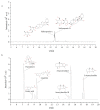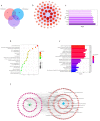Integrating Metabolomics and Network Pharmacology to Explore the Mechanism of Xiao-Yao-San in the Treatment of Inflammatory Response in CUMS Mice
- PMID: 38004472
- PMCID: PMC10675308
- DOI: 10.3390/ph16111607
Integrating Metabolomics and Network Pharmacology to Explore the Mechanism of Xiao-Yao-San in the Treatment of Inflammatory Response in CUMS Mice
Abstract
Depression can trigger an inflammatory response that affects the immune system, leading to the development of other diseases related to inflammation. Xiao-Yao-San (XYS) is a commonly used formula in clinical practice for treating depression. However, it remains unclear whether XYS has a modulating effect on the inflammatory response associated with depression. The objective of this study was to examine the role and mechanism of XYS in regulating the anti-inflammatory response in depression. A chronic unpredictable mild stress (CUMS) mouse model was established to evaluate the antidepressant inflammatory effects of XYS. Metabolomic assays and network pharmacology were utilized to analyze the pathways and targets associated with XYS in its antidepressant inflammatory effects. In addition, molecular docking, immunohistochemistry, Real-Time Quantitative Polymerase Chain Reaction (RT-qPCR), and Western Blot were performed to verify the expression of relevant core targets. The results showed that XYS significantly improved depressive behavior and attenuated the inflammatory response in CUMS mice. Metabolomic analysis revealed the reversible modulation of 21 differential metabolites by XYS in treating depression-related inflammation. Through the combination of liquid chromatography and network pharmacology, we identified seven active ingredients and seven key genes. Furthermore, integrating the predictions from network pharmacology and the findings from metabolomic analysis, Vascular Endothelial Growth Factor A (VEGFA) and Peroxisome Proliferator-Activated Receptor-γ (PPARG) were identified as the core targets. Molecular docking and related molecular experiments confirmed these results. The present study employed metabolomics and network pharmacology analyses to provide evidence that XYS has the ability to alleviate the inflammatory response in depression through the modulation of multiple metabolic pathways and targets.
Keywords: CUMS; Xiao-Yao-San; depression; inflammation; metabolomics; network pharmacology.
Conflict of interest statement
The authors declare no conflict of interest.
Figures









Similar articles
-
Mechanism of Xiaoyao San in treating non-alcoholic fatty liver disease with liver depression and spleen deficiency: based on bioinformatics, metabolomics and in vivo experiments.J Biomol Struct Dyn. 2024 Jul;42(10):5128-5146. doi: 10.1080/07391102.2023.2231544. Epub 2023 Jul 13. J Biomol Struct Dyn. 2024. PMID: 37440274
-
A unique insight for Xiaoyao San exerts antidepressant effects by modulating hippocampal glucose catabolism using stable isotope-resolved metabolomics.J Ethnopharmacol. 2023 Jan 10;300:115702. doi: 10.1016/j.jep.2022.115702. Epub 2022 Sep 12. J Ethnopharmacol. 2023. PMID: 36099982
-
Studies on the potential link between antidepressant effect of Xiaoyao San and its pharmacological activity of hepatoprotection based on multi-platform metabolomics.J Ethnopharmacol. 2020 Mar 1;249:112432. doi: 10.1016/j.jep.2019.112432. Epub 2019 Nov 29. J Ethnopharmacol. 2020. PMID: 31790818
-
Antidepressant effects of the traditional Chinese herbal formula Xiao-Yao-San and its bioactive ingredients.Phytomedicine. 2023 Jan;109:154558. doi: 10.1016/j.phymed.2022.154558. Epub 2022 Nov 21. Phytomedicine. 2023. PMID: 36610123 Review.
-
Efficacy and Safety of Chinese Herbal Medicine Xiao Yao San in Functional Gastrointestinal Disorders: A meta-Analysis and Trial Sequential Analysis of Randomized Controlled Trials.Front Pharmacol. 2022 Jan 20;12:821802. doi: 10.3389/fphar.2021.821802. eCollection 2021. Front Pharmacol. 2022. PMID: 35126152 Free PMC article. Review.
Cited by
-
Exploring the Mechanism of Fufang Danshen Tablet against Atherosclerosis by Network Pharmacology and Experimental Validation.Pharmaceuticals (Basel). 2024 May 16;17(5):643. doi: 10.3390/ph17050643. Pharmaceuticals (Basel). 2024. PMID: 38794213 Free PMC article.
References
Grants and funding
LinkOut - more resources
Full Text Sources

